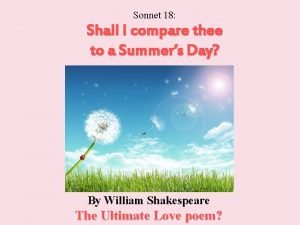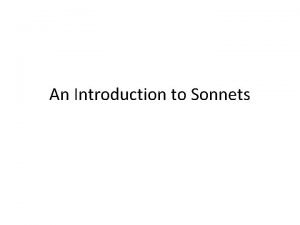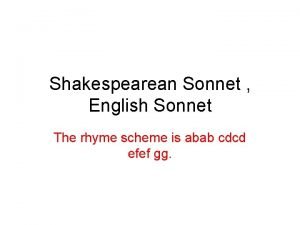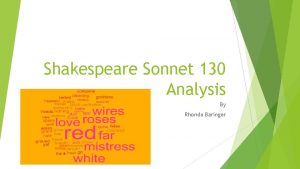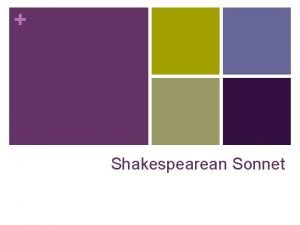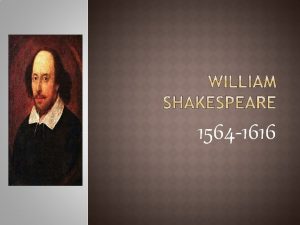The English Sonnet The Sonnet v v v











- Slides: 11

The English Sonnet

The Sonnet v v v Italian origin: The word sonnet comes from Italian sonetto, meaning "little sound" or "little song. " Lyric poems 14 lines Iambic pentameter: U / U / U / Use of conceits: a metaphor that the poet usually extends and elaborates throughout the course of his poem. Poets chronicled stories of unrequited love in sonnet sequences, which were many sonnets tied together with the thread of narrative Check out: Sonnet Central

Development of the Sonnet v v v The first sonnets were written in Italy in the Thirteenth Century. The most famous of the Italian sonneteers were Dante and Petrarch who wrote entire sonnet sequences in the Italian vernacular. The Italian sonnet was introduced into English poetry by Sir Thomas Wyatt. In the late sixteenth century and early seventeenth century, English writers began to imitate their earlier Italian counterparts by writing sonnets in the English vernacular. The most important sonnet sequences written in English were written by Edmund Spenser (Amoretti , published in 1595), Sir Philip Sidney (Astrophel and Stella, published in 1582), and William Shakespeare (his untitled sequence of 154 sonnets was published in 1609). By the reign of Queen Elizabeth, sonnet production became the vogue for its aspiring writers

SONNETS Italian or Petrarchan v Stanzas: English or Shakespearean v Stanzas: v. Octave – first 8 lines: v 3 Quatrains – each presents problem similar images v. Sestet – last 6 lines: v. Heroic Couplet – presents a presents resolution of or paradoxical resolution meditation upon problem v Rhyme: v. Quatrains – abab cdcd efef v. Octave – abba v. Couplet --gg v. Sestet -- cdecde or cdccdc or cddcdd or variation

The English Renaissance The Court of Henry VIII v Wyatt created his sonnets during a period of sweeping artistic and cultural change, in the beginning of an era known as the English Renaissance. v The English Renaissance was dominated by literature, whereas much of the continental European Renaissance was dominated by art and architecture. v By the latter part of the sixteenth century, English literature was characterized by Christian beliefs; in particular, the conflicts created by the dissolving of the Roman Catholic Church and the establishment of the Anglican Church by Henry VIII received much focus. v Wyatt's poetry predates this focus on Christianity, instead showing the influence of the Italian Renaissance and the work of Petrarch.

Henry VIII v Wyatt was a courtier and diplomat in the court of Henry VIII, who was immediately popular upon becoming king in 1509. v He was tall and handsome, with the stature of an athlete, and the people loved him. v As Henry VII was dying, he urged his son to marry Catherine of Aragon, who had been married to Henry's older brother, Arthur, before his death. v Marrying Catherine would maintain the nation's alliance with Spain, which was politically important to England's security. v Six weeks after his father's death, Henry VIII married Catherine, who became queen.

English Sonnets v In the court of Henry VIII, a group of poets arose who would make significant contributions to the development of English literature. Chief among these "courtly makers" were Sir Thomas Wyatt and Henry Howard, Earl of Surrey. With their translations of Petrarch's work, Wyatt and Surrey are responsible for introducing the sonnet form into English. v Wyatt and Surrey also wrote their own sonnets in English, establishing a poetic form and a poetic tradition. v Although its rules of order and arrangement are strict, the sonnet required the sort of discipline that prepared poets for more creative, original works. In polishing their own writing and technique, they also polished English as a fit language for poetic endeavors. Check out: The Makings of Literature in English: The Sonnet Tradition

Sir Thomas Wyatt 1503 -1542 Sir Thomas Wyatt. Sketch by Hans Holbein. The Royal Collection © Her Majesty Queen Elizabeth II

Sir Thomas Wyatt 1503 -1542 v Wyatt is considered the first of the great Elizabethan poets. v His experiments with new formats, especially regarding meter and measure, were very influential in inspiring the great English poets who followed later in the sixteenth century, such as Sir Philip Sidney, Edmund Spenser, and, of course, William Shakespeare. v Wyatt did not publish his poems, but he did circulate them within the Tudor court, where they were read and enjoyed. v As a reflection of Wyatt's importance in the English literary canon, several new editions of his poetry were published in the last thirty years of the twentieth century, offering important insight into his work.

Sir Thomas Wyatt 1503 -1542 v Wyatt can be identified as the father of modern English poetry: with his translations from Petrarch the tradition in English begins. v He uses typical Petrarchan conventions (the lover as a ship tossed on the seas of love; the lover alternately freezing and burning hot, among them]; v His language and syntax are more difficult, making his sonnets a bit tougher to "crack. " v He generally translates from Italian models, which means his themes or issues don't usually originate with him; v He generally follows the rhyme scheme abba cddc effe gg v He often presents the two sides of love--physical and spiritual--but no union between them, which makes his work slightly different from the Petrarchan mold.

Whoso list to hunt, I know where is an hind, But as for me, alas, I may no more; The vain travail hath wearied me so sore, I am of them that furthest come behind. Yet may I by no means my wearied mind Draw from the deer, but as she fleeth afore Fainting I follow; I leave off therefore, Since in a net I seek to hold the wind. Who list her hunt, I put him out of doubt, As well as I, may spend his time in vain. And graven with diamonds in letters plain, There is written her fair neck round about, "Noli me tangere, for Caesar's I am, And wild for to hold, though I seem tame. " Sir Thomas Wyatt Anne Boleyn

